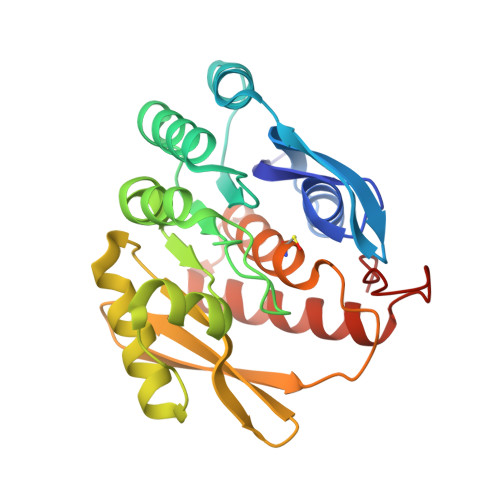Deciphering Structural Traits for Thermal and Kinetic Stability across Protein Family Evolution through Ancestral Sequence Reconstruction.
Cea, P.A., Perez, M., Herrera, S.M., Munoz, S.M., Fuentes-Ugarte, N., Coche-Miranda, J., Maturana, P., Guixe, V., Castro-Fernandez, V.(2024) Mol Biol Evol 41
- PubMed: 38913681
- DOI: https://doi.org/10.1093/molbev/msae127
- Primary Citation of Related Structures:
8G1H - PubMed Abstract:
Natural proteins are frequently marginally stable, and an increase in environmental temperature can easily lead to unfolding. As a result, protein engineering to improve protein stability is an area of intensive research. Nonetheless, since there is usually a high degree of structural homology between proteins from thermophilic organisms and their mesophilic counterparts, the identification of structural determinants for thermoadaptation is challenging. Moreover, in many cases, it has become clear that the success of stabilization strategies is often dependent on the evolutionary history of a protein family. In the last few years, the use of ancestral sequence reconstruction (ASR) as a tool for elucidation of the evolutionary history of functional traits of a protein family has gained strength. Here, we used ASR to trace the evolutionary pathways between mesophilic and thermophilic kinases that participate in the biosynthetic pathway of vitamin B1 in bacteria. By combining biophysics approaches, X-ray crystallography, and molecular dynamics simulations, we found that the thermal stability of these enzymes correlates with their kinetic stability, where the highest thermal/kinetic stability is given by an increase in small hydrophobic amino acids that allow a higher number of interatomic hydrophobic contacts, making this type of interaction the main support for stability in this protein architecture. The results highlight the potential benefits of using ASR to explore the evolutionary history of protein sequence and structure to identify traits responsible for the kinetic and thermal stability of any protein architecture.
Organizational Affiliation:
Departamento de Biología, Facultad de Ciencias, Laboratorio de Bioquímica y Biología Molecular, Universidad de Chile, Santiago, Chile.

















